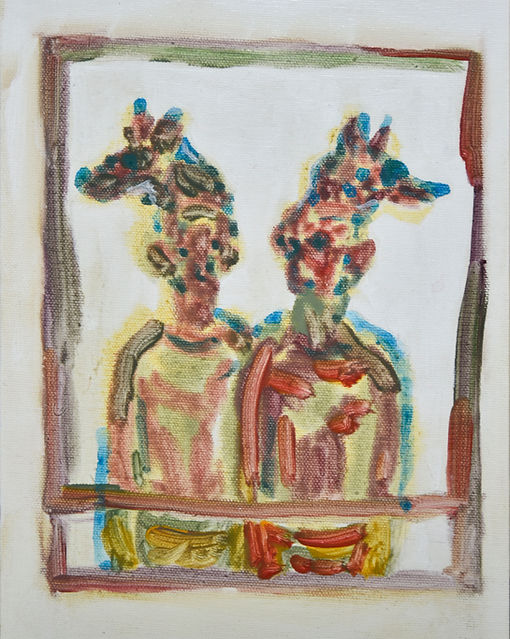
Amplitude|
有本健司
2021年10月17日〜11月20日
硬いゆらぎや、重さ、または重力、
印象は、経験と検索の上位によって定まりを得たようだ
ここ2年ほど交流の波形ような健忘と手触り
視線は画面の中に収納して、日常的な過去をネットサーフィン、未来派の目線を周辺視野で眺め、アルゴリズム
カビ臭さを太陽光で散らしたものだけが、カラフルに匂いとして輝くんだね
また結局、暫定安全地帯に座っています
どの軸に足元から迫られているかなんて、ずっと失念して、報道ヘリ音の順番待ち
音の光が肌に触って痒かったり、心地よかったり、レプシキソーをあてがったりこのように私は世界を認識し、歩かされ、走らされ、既成の手垢まみれポーズして
大地に帰るれと責められた気がして
振幅を意識し メトロノームの音量を思い出そう
振幅を意識し 透過光の0を確認だ
振幅を意識し 遠い過去と遠い未来に靴を飛ばそう
は?
2021 07 有本健司
"2016年に名張を描いた事を思い出し、これらの風景を描いた。( 朝日町の田畑 2016年 )私が居た場所は、今は私が居ない場所で、変化は知らずイメージだけのものになる。抽象化されて、良い部分だけしか覚えていない。
思い出は脚色される。絵具とオイルと筆は、新しいイメージを作る。"
有本健司スタジオビュー
The artist uses objects as memory triggers. Every object contains its own hidden history leaving space for interpretations. Soft colors, svelte forms, blurred silhouettes interchange with sharp cut lines or angles and saturated paints. Taken together the works create tension born of the contrast between the trivial and the context it’s placed in. Thus, connotations are distorted and mystify as in a thriller. For example, representations of kewpie dolls and their heads in vacuum, crosses the boundaries of a children’s game to cause the feeling of anxiety and evil premonition. The detailed depiction of tiny faces outside their role in a child’s game brings forth a strange feeling of a desolated home, terminated childhood and nostalgia. The same feelings are expressed through the works "Move Heart to Birds" and "Move Heart to Birds II", where one sees only the silhouettes of children standing side by side as if in a photograph which has lost its precision and has become fuzzy. Such images convey the sorrow of losing things.
杜甫の詩がインスピレーションを湧かした、とアーティストは語った。
国の都の長安は戦争で破壊されてしまったが、山や河は昔のままである。
町にも春が来て、草木は深く生い茂っている。
このような戦乱の時世を思えば、花を見ても涙が落ちる。
家族との別れを悲しんでは、鳥の鳴き声を聞いても心が痛む。
戦乱ののろし火は、もう何ヶ月も続いていて、家族からの手紙は万金にも値(「あたい」)する(ほど貴重である)。
(悲しみのあまり頭を掻いて)白髪頭を掻けば、(髪が抜けるので)髪は更に薄くなって、簪(かんざし)も挿せなく(させなく)なりそうだ。
-
語注など
春望 ・・・ 春の眺め(ながめ)。
城 ・・・ 城壁で囲まれた都市。この作品では長安のこと。
簪(しん) ・・・ かんむりをとめるピンのこと。


Arimoto bestows his own meaning on surroundings which may better be perceived intuitively and subconsciously rather than literally. Under the artist’s will the same elements may express tragedy and drama or through the use of irony acquire completely different interpretation. The artist expresses his attitude by masterfully changing the angle of view and through using various media creates mini stories with a wide spectrum of perceptions, often ending with absurd arrangement of objects which creates ironical meaning, as in the works Entrance Marker or Each Eye.
Arimoto chooses various media means - from photography and painting to clay and wood - depending on their ability to express a certain image and implication. Landscapes may be represented figuratively or nearly abstractly and are deemed to convey the light and "substance" of the landscape, its image in the artists’s mind.

Space and air are very important in the "portraits" of objects. Objects and subjects on the canvas look like outlines of fading entities. Empty light spots urge us to think about incompleteness, objects seem to be taken unaware at the moment of their emergence into sight. By making something like frames, the artist attempts to connect objects to the ground and at the same time asserts theirs transience. This gives a presentation the nature of "belonging"- through depicting something the artist becomes the owner of the object as well as the time of its creation. We always feel the subjectivity of his view.
Reminiscences, associations with the past, but also new perceptions of reality comprise the basis of Arimoto’s works. Diluted and soft pallet, abstract and figurative forms create a metaphorical world of ambivalent reality. Living in his isolated studio conceived by the artist as "an island of security," he nevertheless always expects the news to come. This excites the artist, keeps him in tension and gives birth to the feeling of fluctuations, where tranquility is interspersed with anxiety. Such mood is well presented in his works at this exhibition.


"私のアトリエの目の前に広がる山に入ると、情報量の多さに圧倒されて目の前のことすら把握することが危うくなる。転がり落ちないように次の足をおく所を探すたびに、過多な情報と多量の物質に気を取られ、一瞬の観察時間がある。
山に入り、私は光と物質にモチーフを求め出した。
この「もがき」のような行動は、印象をとらえる事のようで歴史をなぞっているのかもしれない。
真っ直ぐに近い線で構成されている山の物質はじっくり観察されることなく、情報として一瞬の観察時間のなかにしかない。まるで電車で横切る木々のようだし、You Tubeのなにかの広告で見切れる緑かもしれない。"
In the series of works "Green Friction" various easy on the eye green hues cover the canvas layer after layer. Strong and energetic strokes going in various directions create the feeling of movement. The artist attempts to focus attention on objects of nature - the grass he steps on, the leaves of branches he touches while walking. All these things he sees with his peripheral vision, noticing their movements rather than shape and volume. As if viewed from a moving train one can see multicolored strips, the effect we feel in "Green Friction" consists of fluctuations and their flair.

"中古の太陽光パネルがインターネットで安価に手に入る。クリーンエネルギーとして重宝されたが、どこかでは役目を終えたのだろう。
「The Sun is Watching You」は、お天道様はいつも見ているという意味で使った。日本のアニミズム的な考えを私はいつもどこかで感じているのだろう。"
"点字で描いたのは「見る」ということを考えたからだ。この大きさの点字を目が見えない人は指先で読めないし、目が見える人はこの文字を読めない。
「誰か」のためという、人間の感情が希薄になり、無表情な数字や機械と生活していく中で、私たちは太陽に当たり何を考えるのか。"

"1980年代後半から90年代前半にアトリエがある伊賀市島ヶ原で撮影·プリントされた写真を見つけた。それらは日当たりの悪いロッカーの中で年をとっていました。
2020年にこの地域のアニミズムの力を吸収した作品を作りました。それは異なる地質に埋められて、雨や風にさらされました。化学やテクノロジーから少し離れた場所に居場所を見つけました。"


_JPG.jpg)
%20_JPG.jpg)








_JPG.jpg)

_JPG.jpg)




















